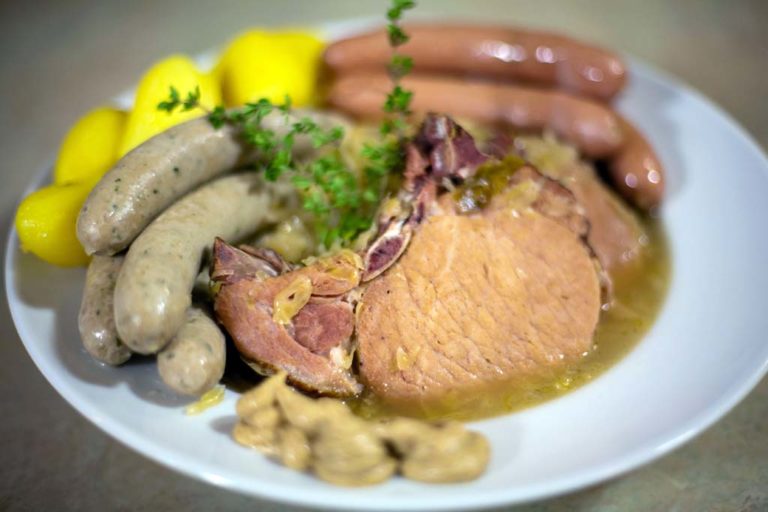
Chef's notes:
Choucroute garnie has its origins in Alsace, a very small region of France that makes up part of its Border with Germany. Alsace, as you may have suspected by the presence of sauerkraut, has some Germanic roots, although it has been a part of France for over 300 years. Many Alsatian wines and beers are popular throughout France and the rest of the world, Riesling anyone? Choucroute garnie being the most famous of all Alsatian dishes is popular all over France and many parts of the world. The recipe I used for this article is a typical choucroute garnie using pork sausages, smoked pork, sauerkraut, duck fat, wine, and juniper berries. In Alsace, the sauerkraut or choucroute is made with juniper berries so we must add some for authenticity.
Ingredients
- 3 Tbsp rendered duck fat
- 1 onion, minced
- 3 garlic cloves, smashed and minced
- 10 juniper berries
- 10 coriander seeds
- 1 bay leaf
- ½ tsp salt
- ½ tsp black pepper, ground
- 2 oz salt pork
- 2 pound sauerkraut, rinsed and drained
- 3 cups Riesling wine
- 2 smoked pork chops
- ½ pound frankfurters
- ½ pound white veal sausage
- Potatoes
- Whole-grain mustard
Choucroute Garnie Recipe with Bockwurst, Frankfurters, Smoked Pork Chops, and Sauerkraut and Mustard
- Assemble the ingredients for choucroute garnie. This recipe is a fairly standard version of the choucroute garnie recipe. Depending on your preferences, you can pretty much substitute anything that you think will taste good. Duck legs, pork ribs, goose breast, pork belly, beef brisket, and so on. The key is to use good sauerkraut, and rinse it first. Also, if you don’t have Riesling on hand, try chardonnay or even chicken stock.
- Fry the onion and garlic in the braising pan. Melt the rendered duck fat (or pork fat, or butter) over medium-high heat in a heavy bottomed braising dish. Saute the onion and garlic in the duck fat until soft and begins to get translucent and break down. Add the juniper berries, coriander, bay leaves, black pepper, salt pork, sauerkraut, and Riesling wine. Simmer for 20 minutes.
- Add the smoked pork chops to the choucroute. Smoked pork chops may be harder to find if you do not have a large population of German immigrants living in your area. Check specialty meat shops and German butchers or sausage makers if you have any. Otherwise you may have to chose another type of smoked meat, like ham, to take its place. Simmer the chops in the choucroute for one hour.
- Boil the potatoes and sausages separately. You don’t have to boil the sausages and potatoes separately, but it makes the presentation looking nicer, and it’s easier to handle. If you want to cook them with the choucroute and smoked chops, add them at the same time. I like my boiled potatoes peeled, but you may not. Also, for a little extra awesomeness, toss the boiled potatoes with a little melted duck fat before serving.
- After 1½ hours of simmering, the choucroute garnie should be done. Now you can arrange the garnie (the meat and potatoes) around the choucroute (the sauerkraut). Don’t forget to serve the juice that the stuff was cooked in. Choucroute garnie goes well with a nice, crusty bread and some whole-grain mustard. Don’t forget to remove the juniper berries before you serve it, or at the very least warn the people eating it.
Tips & Tricks
- If you can’t find salt pork, pancetta will also work. Or even just bacon.
- If you can’t find white veal sausage, substitute boudin blanc, or another white sausage. Some sort of bratwurst or even bockwurst would be good, too.
- Blood sausage or a sausage made of foie gras would be quite tasty in this dish.
- A hot dog is basically a poorly-made Frankfurter using inferior products. You could substitute it as a last resort.
- Some recommend rinsing sauerkraut before you use it, but that will depend on how salty it is. I rinse mine because I want to have the option of adding salt later. If you don’t rinse it, the whole dish will be salty and with no way of removing it at that point. Cooking is about controlling variables, so we rinse the sauerkraut.
